Hydration—or, rather, the lack of it—has been on my mind lately. Recently, I got super sick with some sort of virus, and let’s just say, it wasn’t the respiratory kind. I’ll spare you the gory TMI, but after a couple days of losing more fluid than I could replace on my own, I had to go to the ER. “I’m achy, exhausted, weak, and also foggy and weirdly sad,” I told the doctor as she pricked my arm to attach a rehydration IV. “It’s the dehydration,” she nodded. “It literally affects everything. You’ll feel better after this.” One hour and 1,000 ml of rehydration fluid later, she was right—I did feel better. Not good as new, mind you, but definitely no longer as achy, weak, and tired—and, thankfully, also no longer in the depths of emotional despair. It was kind of magical. So much so, that it made me rethink my commitment to staying hydrated every day. Not just for my body, but for my mind and spirit, too.
When it comes to how much water you should drink a day, you’ve probably memorized this go-to hydration rule: Aim for eight 8 ounces glasses daily. It’s one of those ubiquitous health guidelines that’s been etched into our brains since the beginning of time—right up there with getting our 10,000 steps and eight hours of sleep. It’s also, let’s face it, suspiciously specific. After all, everyone’s body is a little different; we’re all different shapes and heights, we all live in different places and participate in different activities. Can there really be a one-size-fits-all standard for our individual hydration needs?
“Dehydration can cause dizziness and headaches, but it may also affect mood, memory, and motor skills,” explains April Panitz, MS, a New York Certified Dietitian, Registered Nutritionist, and the co-founder of Amenta Nutrition. “We need water for all of our cells and systems to function properly. Water is essential for life.”
What are the signs of dehydration?
Of course, you needn’t wait until you require a trip to the ER to know you’re dehydrated—and in fact, please don’t. There are better, less traumatic ways. The easiest: take a peek before you flush. “Pale, clear yellow urine indicates that you are hydrated, while dark yellow or amber may mean that you’re dehydrated,” explains Panitz, though she notes that certain medications, supplements, and foods can affect the color of your urine. To that end, she recommends also monitoring the frequency of your trips to the bathroom: “You should be going between five to seven times a day,” she says.
It’s also a good idea to monitor other bodily functions as well. “There are several symptoms of inadequate fluid intake, including dry mouth, lips, dry mucous membranes, headache, dry or sunken eyes, and constipation,” explains nutrition scientist and human performance expert Dr. Michael Hartman, PhD.



